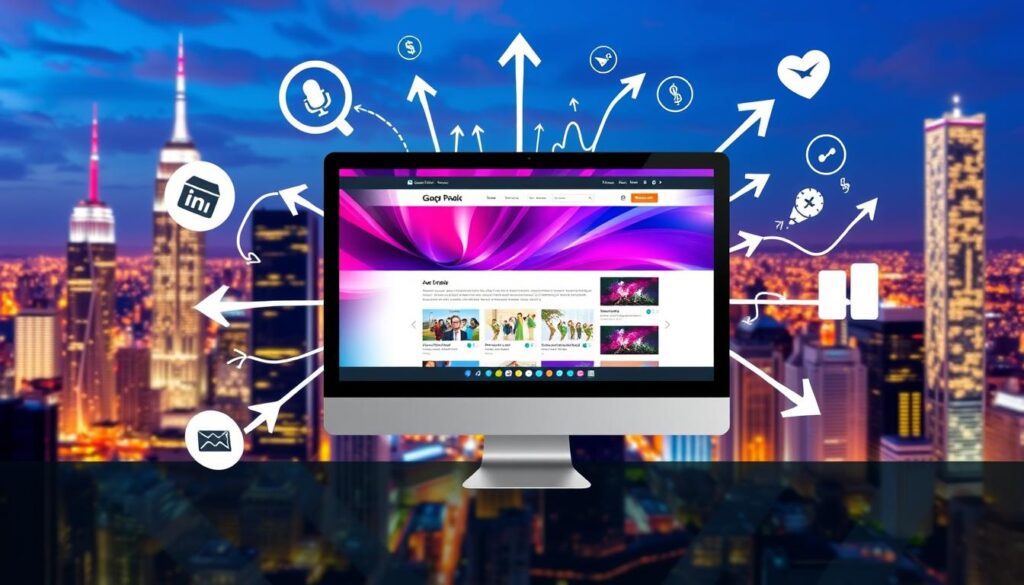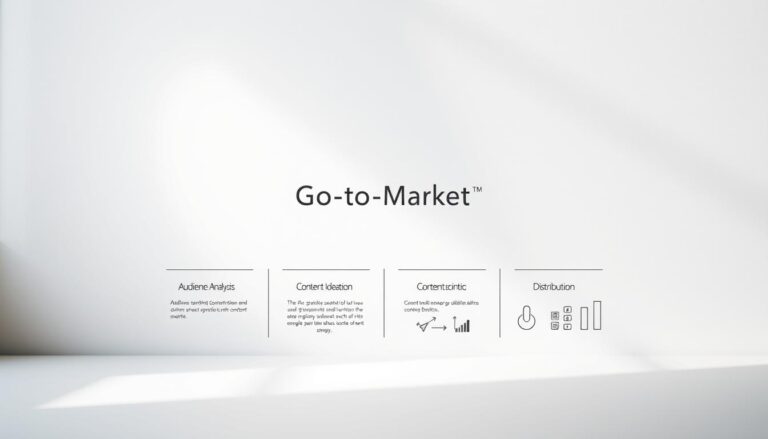In the digital world, businesses need to not only create an online space but also drive targeted website traffic. Bringing in the right people helps increase sales and strengthens your brand. Tools like Google Analytics help you find important keywords to improve website visibility and position online.
By using Mailchimp’s advanced email tools, you can better connect with your goals to enhance website SEO. This leads to more customer interaction.
Key Takeaways
- Effective SEO can lead to a substantial increase in organic website visitors.
- Utilizing Google Analytics reveals the search terms that successfully guide users to your website.
- The creation of backlinks is key to boosting search engine rankings and website credibility.
- Engagement with social media content can result in increased website traffic and visibility.
- Email newsletters serve as a direct line to nurture leads and convert them into loyal site visitors.
- Incorporating local SEO strategies can drive regional business and elevate local service inquiries.
Understanding Targeted Website Traffic
In the digital world, getting quality website visitors is key to online marketing success. It’s not about just more visitors. It’s about attracting people who really want what you’re offering.
What is Targeted Website Traffic?
Targeted traffic is made up of users interested in your products, services, or content. It’s about reaching those more likely to engage and buy. This is done through marketing that focuses on people fitting certain criteria.
Importance of Targeted Traffic
Targeted traffic is efficient and effective. It targets folks already leaning towards your niche. This can boost website traffic, engagement, and conversion rates. Here are the main benefits:
- Higher Conversion Rates: Targeted visitors often convert into customers. That’s because they find what they’re looking for on your site.
- Improved Brand Loyalty: Attracting the right audience regularly builds a strong community. This leads to more repeat buyers and brand fans.
- Better ROI: Targeting specific individuals reduces acquisition costs. Your marketing is aimed at those more likely to convert.
To grow targeted traffic, creating content that meets search intent is crucial. So is using social media and video marketing. Don’t forget the role of guest blogging, partnerships, and mobile-friendly sites in attracting relevant visitors.
To succeed, keep adapting your strategies for your audience’s changing tastes and habits. By doing this, businesses can thrive in today’s competitive digital world.
Identifying Your Target Audience
To really optimize your website for more traffic, you need to understand your audience well. Figuring out who comes to your site can change how you drive web traffic through SEO. It can also help tailor your content better.
Demographic Factors to Consider
Use tools like Google Analytics to see who visits your website. You can find out their age, gender, where they’re from, and what they like. This doesn’t just make your site more visible. It also leads to smarter marketing and more sales.
Here’s a quick list of what to look at:
- Age Distribution: Knowing who your content speaks to helps decide its style and subject.
- Gender Composition: This info can guide your products and how you talk about them.
- Geographic Location: Knowing where your visitors are from lets you make your content more relevant to them.
Behavioral Insights for Effective Targeting
Seeing how people use your website can sharpen your marketing. Look at which pages they view, how they interact, and what they buy. This tells you what they like and how they shop. Using this info helps to optimize website for more traffic. You’ll create content that your audience really connects with.
| Key Insight | Impact |
|---|---|
| User Page Views | Finds content that draws people in |
| Interaction with Content | Shows how well your content works |
| Purchase History | Leads to better product suggestions |
By doing this, businesses can do more than just keep up with what their audience wants. They can stay ahead, making every part of marketing count more. Using both demographic data and how people behave means your online space will not only draw attention. It will also encourage people to interact more meaningfully.
Strategies to Drive Targeted Traffic
To drive targeted traffic well, you need a plan that includes content marketing, SEO, and social media. Each plays a big role in pulling the right people to your site.
Content Marketing Techniques
Content is very important online. It connects you with potential customers. Having a blog can boost your site visits by 55% and get you 97% more site links. Good content attracts more website traffic. It also shows you’re an expert in your field. Using a method like HubSpot’s topic cluster model helps provide detailed resources on key topics. This increases organic traffic.
SEO Best Practices
Using SEO makes your website more visible. The top page on Google gets 71% of clicks. This shows why being high up matters. Essential SEO includes optimized titles, meta descriptions, and image texts. Focusing on long-tail keywords can also help target your audience better. Updating old content can also boost your traffic and keep you ahead in the game.
Social Media Engagement
Being active on social media can really help bring traffic. Sites like YouTube and Pinterest are key due to their wide reach and engaging content. Using targeted ads and participating in groups boosts visibility. It draws people who are more likely to want what you offer.
Using these strategies together is a powerful way to attract and keep visitors. By mixing content marketing, SEO, and social media, you can grow steady traffic. This traffic doesn’t just visit; they engage with the site and could increase your sales.
The Role of Paid Advertising
Paid advertising plays a crucial role in digital marketing. It helps boost website traffic and increase online visibility. If used right, it can bring instant visibility and lots of drive targeted website traffic.
Pay-Per-Click (PPC) Overview
PPC is an online advertising method where advertisers pay each time their ad is clicked. It’s a strategy to buy site visits instead of earning them through SEO. These ads can appear in search results or on social media. They offer immediate visibility and access to a targeted audience.
Social Media Ads vs. Search Ads
Social media ads help marketers target very specific audiences. You can select users based on their interests and behaviors. This makes the ads more effective at driving relevant website traffic. Meanwhile, search ads excel at capturing the attention of people searching online. They find potential customers when they’re looking for products or services like yours.
When choosing between these options, consider what kind of traffic they bring. Also, think about which is more cost-effective for your goals.

| Advertising Type | Strengths | Optimal Use Case |
|---|---|---|
| Social Media Ads | Highly targeted, builds awareness | Brand campaigns targeting specific demographics |
| Search Ads | Immediate visibility, high user intent | Performance marketing with direct response |
| PPC | Cost-effective, scalable, measurable | Businesses looking for quick, quantifiable results |
To drive targeted website traffic well, use both PPC and social media ads. Each platform has unique benefits. Together, they can significantly boost website traffic and enhance marketing ROI.
Leveraging Email Marketing
Email marketing remains a powerful way to drive targeted website traffic and generate more website visitors. It lets businesses keep their audience engaged and grow their numbers.
Building a Quality Email List
It’s crucial to split your email list to boost engagement and lower unsubscribes. Tailored emails, using data on demographics and behavior, help increase open and click-through rates. This approach makes sure your messages hit the right note with your audience.
Personalization in emails is key. Using data to tailor content can significantly increase engagement and drive significant traffic to your site. A detailed list becomes a thick asset for successful email campaigns.
Crafting Compelling Email Campaigns
Catchy subjects and beautiful visuals in emails can make a big difference. Also, with so many reading emails on phones, making them look good on all devices is key. This helps keep people interested.
- Clear, compelling calls-to-action can really boost your website visits.
- Regular newsletters keep subscribers up to date, maintaining a strong connection.
- Special treats for loyal subscribers can build deeper bonds and loyalty.
Effective email campaigns are about timely, well-made messages to a segmented audience. Focusing here helps companies generate more website visitors and drive targeted website traffic. It shows the power of email in digital marketing.
Analyzing Traffic Sources
Today, it’s key to know where your website’s traffic starts. This knowledge helps improve your site’s SEO and draw more visitors. By analyzing traffic sources, you can make your website more visible. This attracts more useful visits from users.
Tools for Tracking Website Traffic
Tools like Google Analytics offer deep insights into your site’s traffic. They show you direct, referral, and search traffic. For businesses aiming to better their site’s performance, these tools are crucial. They let businesses see if their SEO efforts are working. From there, they can improve engagement and conversions.
Understanding Referral Traffic vs. Direct Traffic
Referral traffic comes from other sites or social media links. Direct traffic happens when someone types your URL in their browser. Each type demands a different approach to site optimization and content creation. It’s all about addressing the unique needs of these visitors.
Here’s a deep look at key site metrics and their role in boosting traffic and engagement:
| Metric | Description | Impact |
|---|---|---|
| Bounce Rate | Percentage of visitors who leave without interaction | Lower rates suggest content is more engaging |
| Time on Site | Average duration of a visitor’s session | Longer visits may show content is compelling |
| Pages per Session | Average number of pages viewed per session | More pages viewed means content is engaging and linked well |
| Conversion Rate | Percentage of visitors who complete desired actions | Crucial for seeing if conversion strategies work |
| Click-Through Rate (CTR) | Ratio of users who click a specific link to total viewers of a page, email, or ad | Higher CTR indicates content or ads are effective |

To boost your website’s SEO, dive into these metrics. This will smooth users’ journeys on your site. In turn, it leads to more significant interactions and higher conversion rates. Such insights enable firms to design strategies that truly meet their audience’s needs. This fine-tunes their online presence, ensuring high impact and visibility.
Enhancing User Experience
Boosting your website’s traffic and visibility relies heavily on the user experience (UX) it offers. A great user experience attracts and keeps visitors with easy-to-use design and fast navigation.
Importance of Website Design
A good first impression starts with intuitive, beautiful website design. Clear visuals, matching colors, and easy navigation make users happy and engaged. This leads to more people staying on the site, which can increase sales.
Site Speed and Its Impact
Website speed is very important for user happiness and search rankings. A site that loads slowly loses 40% of its visitors, which shows why fast loading times are essential. Slow websites also cost retailers lots of money in lost sales yearly, proving speed’s importance.
| UX Factor | Impact Before Optimization | Impact After Optimization |
|---|---|---|
| Website Load Time | Over 3s leading to high bounce rate | Under 2s reducing bounce rate by 35% |
| Navigational Ease | Complex navigation causing user frustration | Simplified navigation increasing session duration |
| Content Relevance | Irrelevant content increasing bounce rate | Highly relevant content improving engagement by 50% |
| Mobile Responsiveness | Non-responsive design losing mobile users | Responsive design capturing 80% more mobile traffic |
Better design and faster loading times don’t just get more website visitors. They’re also key for digital marketing today. These changes lead to higher search rankings and long-term success for your business.
Measuring Success and ROI
Businesses aiming to boost their website’s SEO should use Key Performance Indicators (KPIs). KPIs like conversion rate, bounce rate, and time spent on the site are important. They help marketers figure out how visitors act and if their content works. Checking these stats regularly helps in spotting areas to improve user experience. This keeps the website growing in searches.
Key Performance Indicators (KPIs)
To understand SEO’s value, it’s vital to mix analytics and financial measures. SEO’s ROI looks at the profits from organic traffic against the SEO costs. The formula is simple: (Profit from SEO – SEO Costs) / SEO Costs. It focuses on organic visits, keyword ranks, and conversions from searches. This aids in tracking advancements and finding areas that are doing well or need enhancements.
Adjusting Strategies Based on Data Analysis
Optimizing for better ROI has its hurdles. The ever-changing search algorithms and marketing efforts require detailed data review. Marketers need to look at mobile traffic, which is most of the traffic, and use tools like Google Analytics. These tools help understand user behavior. By checking how many visitors turn into customers and keeping an eye on search rankings, firms can simplify SEO’s complex ROI. Using clear calls to action and tailored messages can also improve website ROI. These efforts lead to more relevant traffic and increased financial gains.
FAQ
What is Targeted Website Traffic?
Targeted website traffic is when visitors really interested in what a site offers come to it. They’re more likely to interact with the site. They might even buy something because the site’s stuff matches what they want.
Why is Targeted Traffic Important?
Targeted traffic matters because it’s made of visitors more likely to be interested and buy. Focusing on these visitors can lead to more sales. It’s a better use of resources than just getting lots of random visitors.
What Demographic Factors Should I Consider When Identifying My Target Audience?
When figuring out your ideal customers, think about their age, gender, where they live, their schooling, and how much they make. Knowing these things helps tailor your content and ads to fit what they like.
How Can Behavioral Insights Aid in Effective Targeting?
Looking at what users do on your site, like what they look at and buy, helps understand them better. This info lets you tweak your content and ads to better match what users like and do.
What Content Marketing Techniques Can Drive Targeted Traffic?
Using blog posts, infographics, videos, and webinars can pull in more visitors. The trick is to make content that’s both useful and interesting to your target audience. This way, you answer their questions and meet their needs.
How Can I Utilize SEO Best Practices to Increase Organic Website Traffic?
For better SEO, use the right keywords in your content, get good backlinks, and make sure your site is easy for search engines to go through. Doing this helps more people find you in search results.
What Role Does Social Media Engagement Play in Driving Targeted Traffic?
Being active on social media helps get more specific traffic by sharing great content, talking to followers, and using ads aimed at certain kinds of users. Stay true to your brand and share things your target audience cares about on their favorite platforms.
How Do PPC Campaigns Work?
With PPC, you put ads on search engines and other websites and pay every time someone clicks one. They’re effective because you can pick exactly who sees your ad based on what they’re interested in.
What’s the Difference between Social Media Ads and Search Ads?
Social media ads target users on social sites based on their interests and activities. Search ads show up for people actively looking for something specific on search engines, based on the words they type in.
How Does Building a Quality Email List Help in Driving Traffic?
Having a good email list means you can send messages to people who already like your brand. With emails that really speak to them, you can encourage them to visit your site again.
What Makes an Email Campaign Compelling?
A strong email campaign shares content that really stands out to your readers. By dividing your email list and making messages personal, you get more people interested and visiting your site.
Which Tools Help Track Website Traffic Effectively?
Tools like Google Analytics let you see how people find and use your site. They track lots of things, from where visitors come from to what they do on your site. This helps you understand your audience better.
What’s the Difference Between Referral Traffic and Direct Traffic?
Referral traffic happens when people click links on other sites to get to yours. Direct traffic is from people who type in your web address themselves, likely because they already know about you.
Why is Website Design Important for User Experience?
A well-designed website makes it easy and pleasant for people to look around. Good design helps keep visitors interested and might make them more likely to buy something.
How Does Site Speed Impact User Experience and SEO?
Fast websites make visitors happy because they don’t have to wait. Also, search engines rank quick-loading sites higher. This means more people are likely to find your site.
What are Key Performance Indicators (KPIs) and Why Are They Important?
KPIs are numbers that show how well your site is doing at reaching its goals. Things like how many people buy something, leave quickly, or stay a while are all important. They help you figure out what’s working and what’s not.
How Does Data Analysis Help in Adjusting Website Traffic Strategies?
By looking at your site’s data, you can see what strategies bring in the right kind of visitors. Understanding what your users like helps you make better choices for your ads and content, improving your site’s results.



